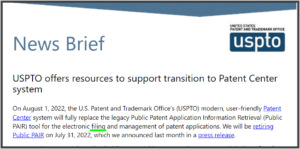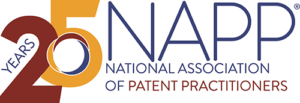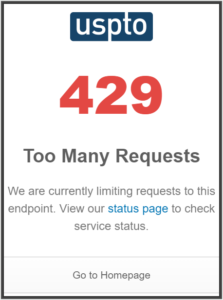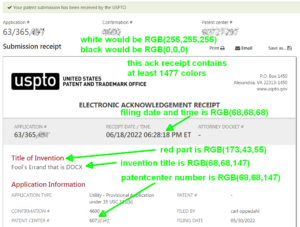This bit of news sort of snuck up on me. Only today did I catch on that five days ago, the Iranian patent office (formally known as the Intellectual Property Center (IPC) of the Islamic Republic of Iran) became a Depositing Office in the DAS system for two kinds of priority documents. Continue reading “Iranian patent office joins the DAS system as a Depositing Office”
Polish patent office becomes trendy, modern, and up-to-date
 I am delighted to be able to report that the Polish patent office has become trendy, modern and up-to-date. Continue reading “Polish patent office becomes trendy, modern, and up-to-date”
I am delighted to be able to report that the Polish patent office has become trendy, modern and up-to-date. Continue reading “Polish patent office becomes trendy, modern, and up-to-date”
Version 2.1.2 of WIPO Sequence software available tomorrow
WIPO has announced that version 2.1.2 of its WIPO Sequence software will be available tomorrow (Wednesday August 3, 2022). You can see the announcement here. Here are action items for ST26 users: Continue reading “Version 2.1.2 of WIPO Sequence software available tomorrow”
Still more must-read for ST26 enthusiasts
Hello dear readers. In recent days I published two blog articles (July 15, 2022 and July 15, 2022) that are must-read articles for anybody who has filed any patent application on or after July 1, 2022 containing a sequence listing. If you have filed any patent application (PCT or non-PCT) on or after July 1, 2022 that contains a sequence listing, and if you have not read those two blog articles, you should read them. After that, you should return to this article and read this article. This article has more information from nice people at WIPO about the ST26 issues that I raised in those articles. Continue reading “Still more must-read for ST26 enthusiasts”
PAIR was for filing patent applications?

Just when you thought you were completely familiar with the USPTO e-commerce systems, you realize you were missing something important for all these years. Yes, it turns out that for all of these years, the Public PAIR system has been used for filing of patent applications. See this USPTO News Brief published today, which is quoted at right. Continue reading “PAIR was for filing patent applications?”
See and hear me at the NAPP Annual Meeting and Conference

Yes, today and tomorrow I will be speaking at the Annual Meeting and Conference of the National Association of Patent Practitioners in Denver, Colorado. Continue reading “See and hear me at the NAPP Annual Meeting and Conference”
Yet another must-read for ST26 users
(Please also read Another must-read article for ST26 enthusiasts.)
Earlier today I posted a blog article entitled A must-read for ST26 filers – a technical issue with the software. Here is a followup article that is yet another must-read for ST26 users. This article provides further information which I learned from nice WIPO person Mike Richardson, information which he posted to the ST26 listserv. Continue reading “Yet another must-read for ST26 users”
A must-read for ST26 filers – a technical issue with the software
(Please also see my followup articles entitled Yet another must-read for ST26 users and Another must-read article for ST26 enthusiasts.) (This article has been updated July 29, 2022 to include some suggestions from the nice WIPO people.)
Hello readers. Have you filed any patent application (PCT or otherwise) in recent days using a sequence listing that you created using version 2.1.0 of the WIPO Sequence software? If so, then this blog article is a must-read for you and there are some action steps for you.
If you are getting ready to file any patent application (PCT or otherwise) in coming days, using a sequence listing, this blog article is likewise a must-read for you. Continue reading “A must-read for ST26 filers – a technical issue with the software”
Patentcenter and TEAS and PAIR and EFS-Web MyUSPTO and Financial Manager are all broken just now

(Update Monday July 11. The USPTO status page now admits that these systems are broken. “Users are intermittently receiving a 429 error code ‘too many requests’ when attempting to log into their USPTO.gov accounts to file in Patent Center, EFS-Web, TEAS and TEASi. The workarounds for this error are clearing the browser cache or switching web browsers. Other USPTO systems may also be affected. The USPTO technical teams are investigating.“)
It looks like Patentcenter and TEAS and PAIR and EFS-Web and MyUSPTO and Financial Manager are all broken just now.
The USPTO switched over to a new and different login system a couple of weeks ago, provided by a company called Okta. The way that you can see change this is that when you log in at any of the six above-mentioned USPTO systems, the throbber (Wikipedia article) looks very different from the way it used to look for the past decade or so. Now the throbber is a sort of hexagon made of blue dots, hovering over the words “signing in”, with corporate branding “Okta” in the lower right corner of the screen.
 At right you can see a screen shot of the USPTO’s newly adopted throbber screen, which as I say first started showing up maybe two weeks ago.
At right you can see a screen shot of the USPTO’s newly adopted throbber screen, which as I say first started showing up maybe two weeks ago.
For most of the past two weeks, the new Okta throbber screen seemed to work fine. But today (Saturday, July 9, around 10 AM Eastern Time) the throbber screen has been throbbing for maybe 45 seconds and then what pops up is the 429 screen that you see quoted at top right.
The practical consequence is that it is impossible to log in at Patentcenter or TEAS or PAIR or EFS-Web or MyUSPTO or Financial Manager.
When you get to the 429 screen, you see that “status page” is a link. I clicked on the link, and it brought me to a new page https://status.okta.com/ on which the Okta company uses lots of green check boxes to cheerfully explain that every one of their systems is operating normally.
The USPTO maintains what it misleadingly calls its USPTO Systems Status and Availability page. When some USPTO system does not seem to be working correctly, it is tempting to visit this page to see whether perhaps somebody at the USPTO has (a) noticed that the system is broken and (b) posted a message on this page to acknowledge that the system is broken. It is normally a complete waste of time to check this page, and today was no exception. Yes the page lists various scheduled maintenance activities that are set for today, but none of them involve any of the six systems mentioned in this blog article. And, predictably, the status page shows no indication that anybody at the USPTO has noticed that these five systems are broken just now.
Returning to the 429 screen quoted at top right, you can also see that “Go to Homepage” is also a link. I clicked on the link, and it brought me to a new page at the USPTO, inviting me to log in. I entered my user ID and clicked “next” and what popped up is a big red message “Unable to sign in”.
If you want to keep up to date on the status of the important USPTO systems, what is quite clear is that checking the USPTO Systems Status and Availability page is not the way to do it. The way to do it is to be a subscriber to the relevant listserv, for example the e-Trademarks listserv, the Patentcenter listserv, the PAIR listserv, and the EFS-Web listserv. Or, I suppose, to be a subscriber to my blog.
Patentcenter developers continue to violate their own rules big time

The Patentcenter developers continue to violate their own rules about how filers are supposed to format their documents. They do not just violate their own rules a little. They violate their own rules big time. The violations by the Patentcenter developers make life more difficult for applicants because it makes acknowledgement receipts nearly unreadable in IFW. (The Image File Wrapper (IFW) is a date-stamped, electronic record of the documents in the file and it is the primary source for viewing the entire history of a patent application. Integrity of IFW is essential.) The violations by the Patentcenter developers make life more difficult for the filer of a third-party submission of prior art, because by the time the Examiner sees the third-party submission, it is nearly unreadable in IFW. It means the Examiner is unlikely to give full consideration to the third-party submission. Continue reading “Patentcenter developers continue to violate their own rules big time”
